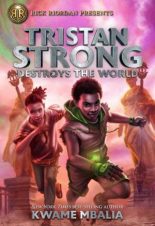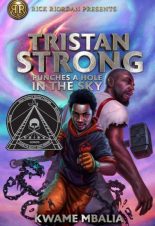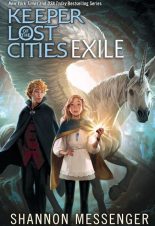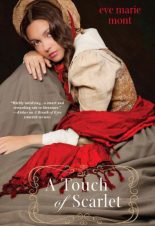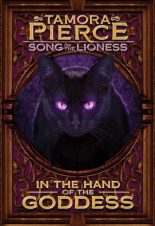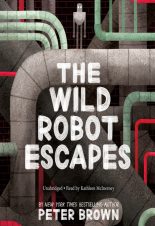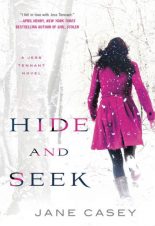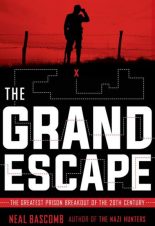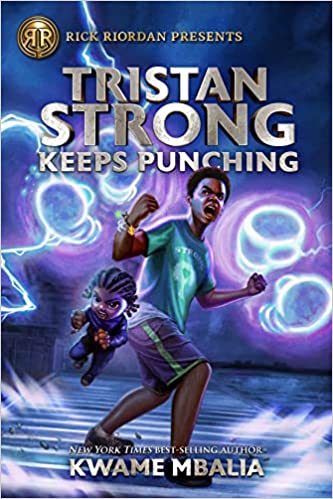
Buy This Book
“My name is Tristan Strong, and boy am I gonna have a story for you,” Tristan Strong, –Tristan Strong Keeps Punching
Tristan Strong Keeps Punching
Tristan Strong #3
by Kwame Mbalia
AR Test, Diverse Characters, LGBTQ
8+
Score
5.0
416
In the final installment of Kwame Mbalia’s series, Tristan’s problems are greater than ever. The gods of Alke are scattered across his world and there are ghosts everywhere — good and bad, as it turns out. What a wonderful time to have a Strong family reunion in New Orleans, amidst all the chaos!
Tristan also has another issue: his powers are flaring with his mood swings, causing him to be covered in magical fire. And of course, Cotton, the main antagonist of the series and a powerful and evil spirit is back and ready to put up a fight. This time Cotton has brought even darker moments from American Black history. Tristan just hopes he can find his friends and the gods of Alke – and figure out how to control his temper – before Cotton can enact his plan on Tristan’s world.
Tristan Strong Keeps Punching wraps up loose ends from the previous two books, includes familiar friends and foes, and introduces new characters in creative ways. For instance, Tristan and his friends encounter the Redliners, a barely disguised reference to the historic practice of redlining in the United States. However, middle school students may who are not familiar with the historical practice of redlining may be confused by Mbalia’s dialogue. For example, the Redliners tell Tristan and his friends, “We, the Redliners, are the most tolerant and welcoming group you could find! We just don’t think you belong here.” The Tristan Strong Series deals heavily with the injustices that have occurred in American Black history, and Mbalia continues to handle the topic with grace and gravity, balancing historical facts with Tristan’s emotional stake in the issues at hand.
In this book, Tristan finds himself reckoning with his grief and anger, and he learns how to handle his emotions in a productive way. His emotions are validated, but he starts to understand how to conduct himself in a manner that accounts for other people involved. Previously, his actions previously endangered his friends. It is only when his magical animated sticky doll friend, Gum Baby, dies that he realizes his actions directly led to her being put in harm’s way. From that point forward, Tristan reckons with the consequences of his actions without losing the fire that keeps him fighting for justice.
Tristan Strong Keeps Punching is an excellent end to the trilogy. Readers should read the first two installments before tackling this one as this book makes many references to the previous books. Young readers will enjoy the fast-paced action plot and the balance between humor and grave historical fact. This book would appeal to fans of Riordan Reads mythology novels, like Aru Shah and the End of Time by Roshani Chokshi or Percy Jackson and the Olympians by Rick Riordan himself. Tristan’s remarkable gift as a storyteller of the gods of Alke is made more perfect by his perseverance to keep telling these important stories. If these books teach readers anything, it’s to keep dreaming, create a better world, and never forget the stories of those who came before.
Sexual Content
- None
Violence
- Tristan must fight various magical and evil entities. In one sequence, Tristan fights a haint (an evil spirit). Tristan narrates, “But I was attacking, too. The shadow gloves flashed in and out, jabs and straights, hooks and uppercuts. Gum Baby flipped from my left shoulder to my right and back again, hurling sap balls and insults with equal intensity. I dodged a slicing strike, slipped a bull rush, and turned and fired three punches at the back of the haint.” This sequence lasts for a chapter.
- There are descriptions of slavery as this series deals heavily with the history of Black Americans and Black American culture. Tristan recounts some of these details, saying, “I read about the barges that had hauled the shackled enslaved north, up the river, to a giant plantation. A free man’s protests were scrawled in the grass of Artillery Park, where he’d been kidnapped and sold into slavery. A family’s prayers were carved into the pillars lining the docks along the Mississippi, where they’d been separated, never to see each other again. These were the hidden narratives Folklore hero and god High John had been talking about. This is what he had meant.” These descriptions come up somewhat frequently throughout the book.
- Tristan fights coffles (malicious spirits) that have trapped some kids. Tristan “swung again and again, trying to take out the coffle before it could rise. The monster wriggled and writhed on the ground, and I had to hop and dodge its flailing limbs or my legs would’ve been ripped to shreds.” This fight sequence lasts for several pages.
- Tristan’s friend, Ayanna, tells Tristan about one of her former friends who died in a fight. She says, “He wanted to go out and kill [evil magical creatures, including the fetterlings], and I didn’t, and we argued about it. He flew into a rage, took his raft, and left. We heard fighting and went out after him, but by then it was too late. The fetterlings used his anger against him, and I lost a friend.”
- Gum Baby is loudly and badly playing music, and Tristan asks her to stop. Gum Baby responds, “Gum Baby’s gonna tune your face with some sweet chin music if you keep talking,” insinuating that she’d hit him with her banjo if he insulted her again. She does not actually hit him.
- Tristan says he thinks Cotton is going to Fort Pillow as he’s “raiding places where Black people suffered in large groups…[Fort Pillow] was the site of one of the biggest massacres of Black soldiers in the entire Civil War. People fighting for their freedom were cut down by Confederate soldiers without remorse.”
- Tristan goes into High John’s memories and sees a town being burned to the ground. “Flames exploded out of broken glass and spread everywhere. More shouts and screams…Flames shot fifteen feet into the air. Every house in the small neighborhood was on fire. I couldn’t see anyone, but the screams…I knew the screams would haunt me for the rest of my life. So many. Old, young. I heard them all.” The memory lasts for a few pages and it is clear that Tristan witnessed the “Memphis Race Riots of 1866. Nearly all of South Memphis was destroyed…Black-owned homes, businesses, restaurants. People were killed. Abused. Beaten. And yet no one was ever brought to justice.”
- Another magical being, Granny Z, tells Tristan, “My children are kicked, beaten, harassed, stolen, abused, abandoned, forgotten and stripped of their rights every single day. And it’s a sad fact that their abusers are always gonna be afraid that their own sins will be revisited upon them.”
- Tristan and his friends Gum Baby, Ayanna, and Thandiwe are attacked in a Wig Emporium. “Gum Baby flipped out of nowhere, her hands moving a blur as sap rocketed through the air. Breakers exploded into smoke five at a time. I limped forward to help her, but she disappeared in a crowd of foes. I tried fighting my way free, but there were too many. We were being overwhelmed.” This scene lasts for a page. Gum Baby dies but the death isn’t described.
- Tristan helps ghosts save their stories from Cotton, who wants them erased. Tristan hears one ghost say, “I moved here to get away from the lynchings.” This point is not elaborated upon.
- Tristan fights with many Breakers, magical creatures that can strip people and gods of their spirits, thereby killing them. Tristan describes how the Breakers “rained blows on me, snarled at me, shrieked at me, roared at me, sent wave after wave after wave of pure hatred and malevolence, and it was all I could do to keep my arms raised and defend myself, because I was so tired, incredibly tired, of defending myself, but it wasn’t just me I was defending, now was it?” The scene lasts for several pages.
- One of the old folk gods, John Henry, fights Cotton. John Henry gripped the ghostly tentacles, “lifted one foot, and then exploded into motion, charging Cotton like a linebacker and planting a shoulder squarely in the haint’s chest. Cotton flew back a dozen yards — through the air! — before landing and skipping across the sand like a stone across a pond.” This battle sequence lasts for several chapters.
- Tristan has one final battle with Cotton that lasts for several pages. Tristan narrates, “Cotton’s momentum carried him past me, and he was off-balance. My right fist, my power fist, knifed through the air and connected flush against Cotton’s chin. Just my fist, not the shadow gloves, because I needed them for what came next…The black flames flared to life one more time, with as much energy as I could muster flowing through them. Just as I’d done on the barge, I willed the gloves together, merging six into two shining beacons of black in the light of the setting sun…I darted forward and grabbed Cotton. He twisted, turned, fought, and struggled, but I didn’t let go. The flames of the akofena [magic] spread to him, devouring the thorns and cotton as if they hungered for the hatred binding the haint together.” Tristan destroys Cotton by turning him to ash.
Drugs and Alcohol
- Tristan ends up at an outdoor strip mall. He says, “Shelves are stocked with products you’d never heard of, or weird stuff you’ve seen advertised on TV — all two-a.m. hangover purchases, as my dad called them. I’m not sure what a hangover is, but if it made me buy an automatic toenail clipper that looked like two machetes taped together, I want no part of it.”
Language
- Gum Baby, a magical sticky being, loudly and frequently refers to Tristan as “Bumbletongue” or “thistle-head.” As they’re friends, it’s done mostly in jest.
- Light language is occasionally used. Words include chump, rejects, and doofus.
- Tristan meets a kid named Memphis, who uses they/them pronouns.
- A slave-patroller haint chases Tristan, yelling, “You ungrateful little stain on society, get over here! I will hunt you down, you hear?”
Supernatural
- Tristan is having issues with his magic. Most notably he keeps bursting into flames when he gets angry. For instance, Tristan notes, “I stared in utter horror at the small silver flame popping out of my knuckles.” This happens frequently throughout the book.
- As this is the third installment in the series, Tristan gives a quick recap of the last couple books. He says of his summer, “I’d eaten a bunch of key lime pie, done a little boxing, fallen into another world with powerful gods and made a bunch of folk hero friends…You know, the normal summer.” These gods and folk heroes feature throughout the book as Tristan is trying to rescue them.
- Tristan’s magical smartphone is controlled by Anansi, the trickster god. Tristan says, “He was the Weaver, the owner of all stories, from truths to tall tales, and his name was embedded in my title of Anansesem.”
- Tristan and his granddad enter Congo Square in New Orleans, where “ghostly apparitions dressed in their Saturday night finest were hitting moves that made my calves cramp as I watched…as if on cue, everybody started doing the Electric Slide.” Ghosts appear frequently in this book; many of them are friendly or give helpful advice.
- Gum Baby announces that she’s been following a “ghostie” for a while because it was terrorizing everyone. This creature is like the haints, which are malicious spirits. Tristan describes the creature, saying, “I looked up and saw a long, lanky creature scuttling down from the top of the wheelhouse like a monstrous crab.” The group spends a chapter fighting the creature.
- Tristan discovers that the haint that they’ve encountered is a coffle. His cousin explains its odd appearance, saying, “They were used to fasten slaves together when they were marched from the house to the fields and back.” Tristan describes its appearance, “Two long, wooden, bone-like structures protruded from the opposite sides of a loop, forming what looked like the skull of a hammerhead shark. Its body was a chain, and its four limbs were thorny, viny branches.”
- Tristan’s magic storyteller abilities occasionally cause him to have visions. In one instance, he describes, “I saw stories — written in French and Spanish and Chitimacha and English — about the birth of jazz and the death of neighborhoods. I saw tales of Fon and the Ewe and the Igbo, and legends of Vodun and Vodou and the spirits within…I read about the slave ports that had dotted the Mississippi River. I read about the glamorous buildings that had been built around the sale of men, women, girls, and boys like me. Some older, some younger.” This description continues for several pages.
- Cotton is the main antagonist of the series and is a powerful and evil haint. He is a manifestation of the evils of slavery. Tristan describes, “I once again saw the horrific true form of the haint underneath the disguise. Complete with his burning hatred and desire for power.”
- A god, Mami Wata, rides in a boat that encounters Angola. Tristan notes that “a monstrous, nearly see-through house was superimposed over the prison…The house I was seeing was Old Angola, a long-gone plantation.” In this house and prison reside many trapped spirits and evil haints, including Cotton.
- Tristan’s usual Ananasem powers (storytelling powers) change when he meets ghosts of former soldiers. He says, “I was inside the story!” In this instance, the sequence lasts for several pages and details the lives of a couple Black soldiers escaping the South to Vicksburg.
- Tristan teaches some kids magic. When he tells them what he’s going to do so, one kid responds, “Ain’t no wizards ‘round here. That’s movie stuff.” Tristan then demonstrates that all the kids have magic within them. Tristan says, “Each of the kids had a story fragment nestled in their chest, right above their heart. A piece of the story of Alke lived on in each of them.”
- Tristan meets Granny Z, who tells Tristan about Loa. Granny Z says, “L-O-A. The mysteres. The links between the High God and his people on earth, serviced by the mambos, their priestesses.”
- Tristan and his friends drive a magic SUV after a magical horse that’s kidnapped a child. Tristan says, “We looked out the front windshield to see Twennymiles (the horse) leaping into the air and disappearing. Old Familiar (the SUV) followed.” They are magically transported through the air and through neighborhoods, and the scene lasts for a couple pages.
Spiritual Content
- Tristan encounters many different gods (like Anansi and Mami Wata) on his journey, and they’ve given him powerful artifacts for his magical powers. These gods exist throughout the book, and sometimes Tristan mentions his magical gifts. He says, “I reached for the adinkra bracelet on my right wrist. Dangling from it were my gifts from the gods. The Anansi symbol. The akofena from High John. The Gye Nyame charm. The Amagqirha’s spirit bead from Isihlangu. They gave me strength, power, and right now, all the confidence I needed.”
- Tristan meets a girl named Hanifa, who “wears a hijab.”
- The gods of Alke, due to the events of the previous books, are now scattered in Tristan’s world. Some of them are weakened and some die in nonviolent ways. Tristan often laments that “Gods can’t die,” but the events of the book say otherwise, like when High John passes away beneath a tree.
- High John’s ghost tells Tristan, Ayanna, and Thandiwe about his upbringing and the influence of the Church. He says, “some Sundays, his lordship and most honorable, the man who wanted to be called Boss, graciously allowed the people who actually worked the fields to rest.”
“My name is Tristan Strong, and boy am I gonna have a story for you,” Tristan Strong, –Tristan Strong Keeps Punching
Latest Reviews

A Tale of Magic

The Immortal Fire

Grace Hopper: Queen of Computer Code

Girls Who Code: Learn to Code and Change the World

Alone

Friends Fur-Ever

Harry Houdini: A Magical Life

The Greedy Gremlin

Hoop Genius: How a Desperate Teacher and a Rowdy Gym Class Invented Basketball

